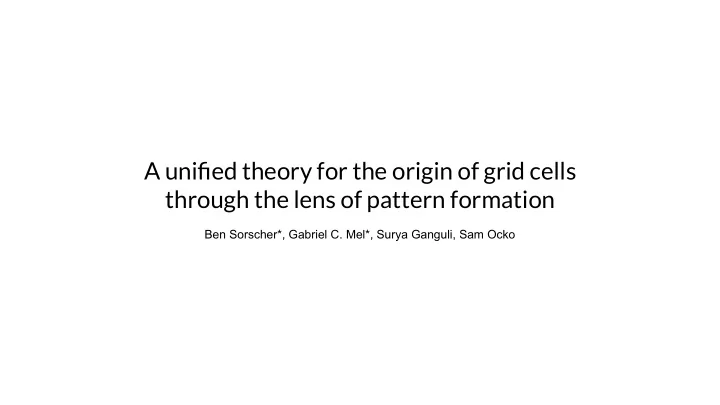

A unified theory for the origin of grid cells through the lens of pattern formation Ben Sorscher*, Gabriel C. Mel*, Surya Ganguli, Sam Ocko
Grid cells Krupic et al. (2012), Derdikman (2014)
Trained neural networks learn grid patterns Banino et al. (2018) Cueva & Wei (2018) unconstrained Dordek et al. (2016) Stachenfeld et al. (2014) nonnegative
Trained neural networks learn grid patterns
1. Why are the optimal maps grids? 2. What determines the optimal grid type - square, amorphous, or hexagonal?
Gradient descent as a pattern forming dynamics
Gradient descent as a pattern forming dynamics
Gradient descent as a pattern forming dynamics 1. Why are the optimal maps grids?
Gradient descent as a pattern forming dynamics 1. Why are the optimal maps grids? Translation invariance => Fourier modes
1. Why are the optimal maps grids? Translation invariance => Fourier modes 2. What determines the optimal grid type - square, amorphous, or hexagonal?
1. Why are the optimal maps grids? Translation invariance => Fourier modes 2. What determines the optimal grid type - square, amorphous, or hexagonal?
Nonnegativity yields hexagonal grids
Nonnegativity yields hexagonal grids
Nonnegativity yields hexagonal grids Taylor expand constraint
Nonnegativity yields hexagonal grids Taylor expand constraint “Three-body interaction” between stripes 60 o apart
Nonnegativity yields hexagonal grids Taylor expand constraint “Three-body interaction” between stripes 60 o apart
Unifying mechanistic and normative models Grid cell model RNNs Normative encoding models Skaggs et al. (1995) Banino et al. (2018) Zhang (1996) Cueva & Wei (2018) Fuhs and Touretzky (2006) Dordek et al. (2016) Burak and Fiete (2009) Stachenfeld et al. (2014)
Unifying mechanistic and normative models Grid cell model RNNs Normative encoding models Gradient Activity descent dynamics Skaggs et al. (1995) Banino et al. (2018) Zhang (1996) Cueva & Wei (2018) Fuhs and Touretzky (2006) Dordek et al. (2016) Burak and Fiete (2009) Stachenfeld et al. (2014) Pattern forming dynamics
Unifying mechanistic and normative models Grid cell model RNNs Normative encoding models Gradient Activity = descent dynamics Skaggs et al. (1995) Banino et al. (2018) Zhang (1996) Cueva & Wei (2018) Fuhs and Touretzky (2006) Dordek et al. (2016) Burak and Fiete (2009) Stachenfeld et al. (2014) Pattern forming dynamics
Recommend
More recommend